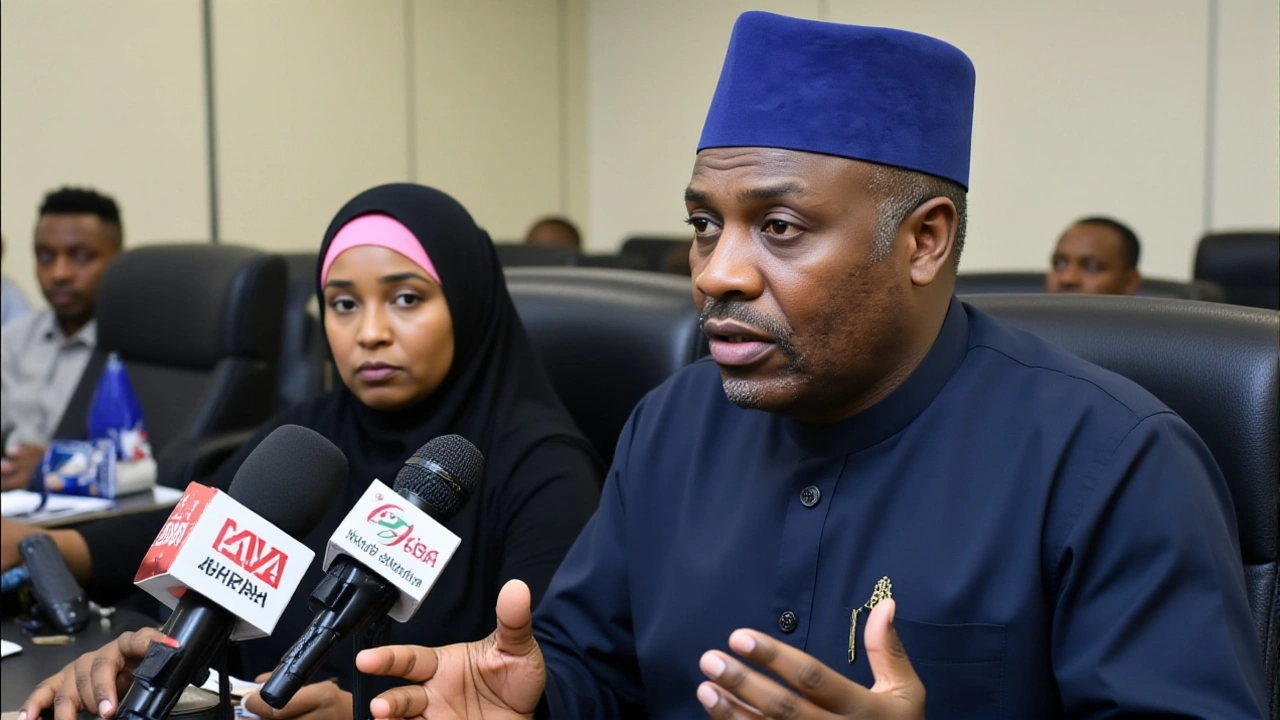When Professor Chris Piwuna, National President of Academic Staff Union of Universities stepped up to the podium at the University of Abuja on Sunday, October 12, 2025, he announced a two‑week nationwide strike beginning at midnight on October 13. The move comes after a 14‑day ultimatum issued on September 28 slipped by without a concrete response from the Federal Government of Nigeria. In a press conference, Prof. Piwuna warned that the strike would be total and comprehensive, aiming to force the government to sign and implement a renegotiated agreement on university funding, staff welfare and infrastructural overhaul.
Background: A long‑standing tug‑of‑war
ASUU has a history of industrial action dating back to the early 2000s, when the union first demanded regular pay arrears and better research facilities. The last major strike in 2022 lasted four weeks and crippled most public campuses, leaving tens of thousands of students stranded. Over the years, the union’s grievances have crystallised around three pillars: delayed salaries, inadequate infrastructure, and the chronic under‑funding of tertiary institutions. According to a 2023 audit, public universities receive less than 5% of the national budget, a figure that has barely budged despite repeated promises from successive administrations.
The latest ultimatum and strike declaration
On September 28, 2025, ASUU’s National Executive Council adopted a 14‑day notice demanding that the government honour its pledges on earned academic allowances, the release of a long‑awaited needs‑assessment report, and the establishment of a single, transparent negotiation platform. The notice read, “The federal and state governments have a habit of paying little or no attention to the education sector.” Prof. Piwuna reiterated that the notice expired on October 11 with "no meaningful progress". The union therefore resolved to launch a nationwide two‑week warning strikeNigeria, affecting every public university from Lagos to Kano.
Government’s recent intervention and the new negotiation committee
Just three days before the strike, Dr. Tunji Alausa, Minister of Education announced a N200 billion intervention package. The package earmarks N50 billion for earned academic allowances already released, plus N150 billion in the 2025 budget for university revitalisation projects. He stressed that President Bola Tinubu has directed that "students must remain in school" while negotiations continue.
The minister also unveiled the Mahmud Yayale Ahmed Federal Government Tertiary Institution Expanded Negotiation Committee, a single body that will engage all tertiary unions – universities, polytechnics and colleges of education – under one roof. According to Dr. Alausa, the former three‑committee system was “inefficient” and the new structure should expedite a “full understanding of their needs”. The Technical Working Group, he said, would transmit a counter‑offer to the expanded committee "by the end of today or tomorrow".
Reactions from students, academics and analysts
Student bodies across the country reacted with a mix of frustration and apprehension. The National Association of University Students (NAUS) released a statement urging calm, noting that "the strike will halt exams, research projects and potentially delay graduations for an entire cohort, many of whom are already financially strained". Meanwhile, senior lecturers at the University of Ibadan warned that prolonged closures could erode research output, jeopardising international collaborations and grant funding.
Education analysts see the situation as a classic stalemate. Dr. Aisha Bello, a senior fellow at the Nigerian Institute of Policy and Research, said, "The government's N200 billion pledge looks impressive, but without a reliable disbursement mechanism, it risks becoming another headline rather than a solution." She added that the demand for a legislative clause requiring institutions to exist for five to ten years before accessing TETFUND money could reshape funding dynamics, but implementation will be key.
Potential impact and what comes next
If the strike proceeds as announced, the immediate effect will be a complete shutdown of lectures, laboratories and administrative services in over 70 public universities. A recent estimate by the Tertiary Education Trust Fund suggests that a two‑week halt could cost the economy roughly N12 billion in lost tuition fees, research revenue, and ancillary services. Moreover, the interruption may exacerbate brain‑drain trends, with some academics reportedly considering offers from overseas institutions.
Looking ahead, the expanded negotiation committee is expected to present a revised offer within the next 48 hours. Should the government’s counter‑proposal meet ASUU’s core demands – especially the guaranteed release of the needs‑assessment report and a clear timeline for the N150 billion budget tranche – the strike could be averted. However, insiders warn that the union’s leadership is prepared to sustain pressure, citing past experiences where half‑measures only delayed inevitable industrial action.
- When: Strike runs from Oct 13 to Oct 27, 2025.
- Who: All public universities under the Academic Staff Union of Universities.
- Why: Government’s failure to honour a 14‑day ultimatum on funding and staff welfare.
- What’s at stake: N200 billion intervention, student enrollment continuity, research output.
- Key players: Prof. Chris Piwuna, Dr. Tunji Alausa, President Bola Tinubu, Mahmud Yayale Ahmed committee.
Frequently Asked Questions
How will the strike affect current university students?
Students will see all classes, exams and laboratory work suspended for two weeks, delaying graduation timelines and potentially affecting scholarship eligibility. Many universities also provide meals and transport; those services will be halted, adding financial strain for students already coping with high tuition fees.
What are ASUU’s main demands beyond the salary arrears?
Besides prompt payment of earned allowances, ASUU insists on the release of a comprehensive needs‑assessment report, a clear rollout plan for the N150 billion budget tranche, increased development levy from 2% to 4%, and legislation that only institutions with at least five years of operation can access TETFUND resources.
Is the government’s N200 billion intervention sufficient?
The funds represent a sizable increase over past allocations, but critics argue that without transparent disbursement mechanisms and a schedule for release, the money may not reach the most needy departments. Past interventions have been delayed, leading to skepticism among union leaders.
What could happen if the strike continues beyond two weeks?
Prolonged shutdown could trigger a cascade of consequences: loss of research grants, cancellation of international collaborations, increased dropout rates, and heightened pressure on the government to impose a "no work, no pay" policy. It may also force the administration to reconsider its negotiation stance.
When is a resolution expected?
The expanded negotiation committee has promised a counter‑offer within 48 hours of the strike’s start. If both sides engage in good faith, a provisional agreement could be signed before the strike’s midpoint, potentially limiting disruption to the academic calendar.







Halbandge Sandeep Devrao
October 12, 2025 AT 22:50 PMAnalyzing the current ASUU impasse through a policy‑lens reveals a chronic under‑allocation of fiscal resources to tertiary education, a pattern that has persisted across successive administrations. The recent N200 billion package, albeit sizeable, lacks a transparent disbursement schedule, which undermines its efficacy. Moreover, the statutory requirement for institutions to demonstrate a minimum operational tenure before accessing TETFUND could exacerbate the liquidity crunch. In light of these structural deficiencies, the union's decision to initiate a nationwide two‑week strike appears to be a strategic lever to compel compliance with previously articulated funding commitments. Stakeholders must therefore engage in a data‑driven negotiation framework to avoid further erosion of research capacity.
One You tea
October 16, 2025 AT 20:19 PMWhat a catastrophic showdown! The government’s half‑hearted promises are nothing but a façade, and the students are left to bear the brunt of this bureaucratic reelment. You can feel the tension simmering across campuses from Lagos to Kano, and the atmosphere is electrifying in the worst possible way. Honestly, this is the kind of drama that makes headlines but forgets the human cost.
s.v chauhan
October 20, 2025 AT 17:47 PMHey folks, I get why the union feels forced into this action – they’ve been patient for far too long. Let’s keep the conversation constructive and think about how we can support students who are now facing delayed graduations. Maybe we can mobilize peer‑to‑peer tutoring groups during the downtime so learning doesn’t completely halt. It’s essential we stay united and push for a swift, fair resolution.
Thirupathi Reddy Ch
October 24, 2025 AT 15:16 PMThe whole episode reeks of elitist manipulation.
Anil Puri
October 28, 2025 AT 12:44 PMHonestly, the media’s portrayal of the strike is just another spin to keep the public distracted from the deeper corruption. They talk about “funding gaps” but never mention the shadow budgets that line the pockets of certain officials. The N200 billion pledge? It’s likely earmarked for projects that never see the light of day. Meanwhile, the union’s demands are framed as noble, yet they conveniently ignore the fact that many lecturers are already benefiting from overseas grants. If you look at the numbers, the actual shortfall is marginal compared to the misallocation. So before we crown anyone hero or villain, let’s examine the ledger. The real story is about power, not money.
Bhaskar Shil
November 1, 2025 AT 10:12 AMBuilding on that point, the systemic inefficiencies stem from a lack of integrated financial oversight mechanisms within the tertiary sector. By introducing a unified audit framework, we could ensure that allocations are tracked in real‑time, reducing the opacity that fuels speculation. Such a governance model would align with international best practices and could restore stakeholder confidence. It’s a practical step that warrants serious consideration.
Hemakul Pioneers
November 5, 2025 AT 07:41 AMFrom a philosophical standpoint, this standoff reflects a clash between collective welfare and institutional inertia. The university, ideally a bastion of enlightened discourse, now finds itself shackled by bureaucratic inertia. Yet, the very act of striking is an exercise of moral agency, asserting the right to demand equitable conditions. If the dialogue falters, the intellectual community must seek alternative avenues to preserve its integrity.
Sonia Arora
November 9, 2025 AT 05:09 AMThe cultural ripple of this strike cannot be overstated – it reverberates through families, local economies, and the very narrative of progress in Nigeria. Students, who are the torchbearers of future innovation, face an uncertain horizon, and that fuels a collective anxiety palpable across campuses. Moreover, the arts and humanities suffer when lectures are silenced, stifling creativity that fuels societal evolution. It is imperative we recognize the broader cultural stakes at play.
abhinav gupta
November 13, 2025 AT 02:38 AMSure the govt will sort it out tomorrow who knows
vinay viswkarma
November 17, 2025 AT 00:06 AMThe union’s move is a clear signal: no more half‑measures.
Jay Fuentes
November 20, 2025 AT 21:35 PMExactly! Let’s hope the talks finally get moving and everyone gets back on track soon.
Veda t
November 24, 2025 AT 19:03 PMGovernment promises are just smoke; the strike will only expose their incompetence.
akash shaikh
November 28, 2025 AT 16:31 PMSo you think the strike will magically solve everything? That seems a bit naive, doesn’t it?
poornima khot
December 2, 2025 AT 14:00 PMIt is crucial that we maintain a balanced perspective during this turbulent period. While the strike undeniably disrupts academic activities, it also underscores the urgency of addressing systemic under‑funding. Constructive dialogue, backed by empirical evidence, will pave the way for sustainable reforms. Let us encourage all parties to engage earnestly and prioritize the long‑term welfare of the educational ecosystem.
Mukesh Yadav
December 6, 2025 AT 11:28 AMThere is a hidden agenda behind the government's so‑called intervention, one that the mainstream narrative conveniently overlooks. First, the disbursement of the N200 billion is tied to opaque contracts that funnel money into the hands of a select few, effectively sidelining the very institutions that need it most. Second, the timing of the announcement, just days before the strike, suggests a calculated move to appear responsive while actually buying time. Third, the formation of the expanded negotiation committee is a façade; its composition lacks genuine representation from rank‑and‑file academics, reducing it to a rubber‑stamp body. Fourth, the promised N150 billion tranche is earmarked for infrastructure projects that have historically suffered from chronic delays and cost overruns. Fifth, without a transparent audit trail, these funds risk being absorbed into the existing corruption pipeline. Sixth, the government's emphasis on “students must remain in school” ignores the immediate financial hardships many students face due to halted scholarships. Seventh, the ongoing brain‑drain phenomenon will accelerate if the strike persists, as academics seek stable environments abroad. Eighth, international partners are watching closely; any perception of instability could jeopardize future research collaborations. Ninth, the union's demands for a legislative clause on institutional tenure could be a strategic maneuver to lock in long‑term funding, but only if the government follows through. Tenth, rumors circulate that certain ministries are already redirecting the funds to unrelated projects, a claim supported by insider leaks. Eleventh, the lack of an independent monitoring entity means there is no accountability mechanism for the allocated resources. Twelfth, public sentiment is eroding, with citizens growing weary of recurring crises that impact the nation’s future. Thirteenth, the media's coverage remains superficial, failing to scrutinize the deeper financial machinations. Fourteenth, the eventual resolution will require not just financial infusion but structural reforms to the governance of tertiary education. Fifteenth, until such comprehensive measures are enacted, any strike will only be a temporary band‑aid to a systemic wound.
Yogitha Priya
December 10, 2025 AT 08:57 AMThe points raised are indeed concerning.